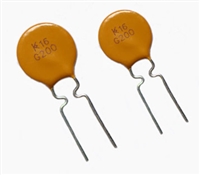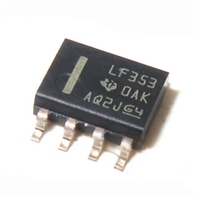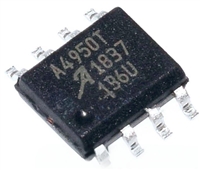The baseline signal count when the electrodes are 'dry'
should begin at over 300 counts or more if possible. With a
small, weakly coupled electrode the baseline signal can be
trimmed to be closer to the 250 mark with a potentiometer to
provide a higher apparent gain by closing the gap between
the baseline and T1 (see below). The spread between T2 and
T1 is fixed and cannot be separately trimmed.
3.3 INTERFACING
3.3.1 OUT LINES AND
P
OLARITY
SELECTION
The QT114 has two OUT pins, OUT1 and OUT2, which
correspond to the crossings of signal at T1 and T2
respectively. Each output will become active after the
threshold is crossed, and after the slosh filter (if enabled) has
settled to its final state. The polarity of the OUT lines is
Increasing Cs will increase the baseline counts, while determined by pin 5, 'POL', as follows:
increasing Cx will decrease it. When optimally tuned, each
POL = Gnd
POL = Vcc
Outputs active low
Outputs active high
threshold point will be symmetrically bracketed by signal
swing, with an intermediate count at about 200 between the
two. Thus, the lower electrode level should cause a signal There is no timeout on these outputs; the OUT lines will
swing that (when 'dry') starts at 300 or more and when remain active for as long as the thresholds are crossed.
covered ends at about 200. The upper electrode when
The OUT lines can sink up to 5mA of non-inductive current. If
covered should generate a signal level of 100 or less.
an inductive load is used, like a small relay, the load should
be diode clamped to prevent device damage.
There is a hysteresis of 3 counts around both T1 and T2.
The signal can be viewed for setup purposes with an
oscilloscope via a 10x or FET probe connected to a 2M ohm
resistor as shown in Figure 1-1; the resistor is required to
reduce the loading effect of the scope probe capacitance.
When viewed this way the signal will appear as a declining
slope (Figure 3-1). The duration of the slope corresponds to
the burst length: each count of burst takes approximately 7
microseconds on average. The ‘low level’ threshold at 250
counts is at 1750 microseconds from the start of the
waveform, while the 150 count ‘upper’ threshold is at about
1050 microseconds from the start, at 3 volts Vcc. These trip
points can be easily observed by monitoring the OUT lines
while watching the signal on a scope, by increasing Cx
loading until each OUT line activates in turn. FILT should be
off to speed up response during testing.
POL strapping can be changed 'on the fly'.
Cycling and Stiction: Care should be taken when the QT114
and the loads are powered from the same supply, and the
supply is minimally regulated. The QT114 derives its internal
references from the power supply, and sensitivity shifts can
occur with changes in Vcc, as happens when loads are
switched on. This can induce detection ‘cycling’, whereby a
trip point is crossed, the load is turned on, the supply sags,
the trip is no longer sensed, the load is turned off, the supply
rises and the trip point is reacquired, ad infinitum. To prevent
this occurrence, the outputs should only be lightly loaded if
the device is operated from a poorly regulated supply.
Detection ‘stiction’, the opposite effect, can occur if a load is
shed when an Out line becomes active.
3.3.2 HEARTBEAT™ OUTPUT
The QT114's internal clock is dependent on Vcc; as a result,
the threshold points in terms of delay time from the start of
the burst are also substantially dependent on Vcc, but they
are always fixed in terms of signal counts. A regulated power
supply is strongly advised to maintain the proper calibration
points.
Both OUT lines have a full-time HeartBeat™ ‘health’ indicator
superimposed on them. These operate by taking both OUT
pins into a 3-state mode for 350µs once before every QT
measurement burst. This state can be used to determine that
the sensor is operating properly, or, it can be ignored using
one of several simple methods.
Potentiometer adjustment: The external potentiometer shown
in Figure 1-1 is optional and in most cases not required. In
situations where the electrode pickup signal is weak,
trimming may be necessary on a production basis to make
the device sensitive enough. Trimming affects the baseline
reference of the signal, and thus effects the amount of
change in the signal required to cause a threshold crossing.
If active-low polarity is selected, the HeartBeat indicator can
be sampled by using a pulldown resistor on one or both OUT
lines, and feeding the resulting negative-going pulse(s) into a
counter, flip flop, one-shot, or other circuit (Figure 3-2). In this
configuration, the pulldown resistor will create negative-going
HeartBeat pulses when the sensor is not detecting fluid;
when detecting fluid, the OUT line will remain low for the
duration of the detection, and no pulse will be evident.
Potentiometer trimming is not a substitute for a good choice
of Cs. In low signal situations Cs should still be
determined by design to allow the baseline signal to be
just beyond T1 as viewed on a scope. The trimmer should
then be added and the baseline adjusted to the necessary
final resting point.
The trimmer should never be adjusted so that the
resistance from ground to SNS1 or SNS2 is less than
200K ohms. If the resistance is less than this amount, the
gain of the circuit will be appreciably reduced and it may
stop functioning altogether. A 200K resistor from the wiper
to ground can be added to limit trim current at the
extremes of wiper travel.
Figure 3-1 Burst Waveform at 2M Pickoff Resistor
LQ
7
QT114 R1.04/1106






 NTC热敏电阻与PTC热敏电阻的应用原理及应用范围
NTC热敏电阻与PTC热敏电阻的应用原理及应用范围

 GTO与普通晶闸管相比为什么可以自关断?为什么普通晶闸管不能呢?从GTO原理、应用范围带你了解原因及推荐型号
GTO与普通晶闸管相比为什么可以自关断?为什么普通晶闸管不能呢?从GTO原理、应用范围带你了解原因及推荐型号

 LF353数据手册解读:特性、应用、封装、引脚说明、电气参数及替换型号推荐
LF353数据手册解读:特性、应用、封装、引脚说明、电气参数及替换型号推荐

 A4950资料手册解读:特性、应用、封装、引脚功能、电气参数及代换型号
A4950资料手册解读:特性、应用、封装、引脚功能、电气参数及代换型号
